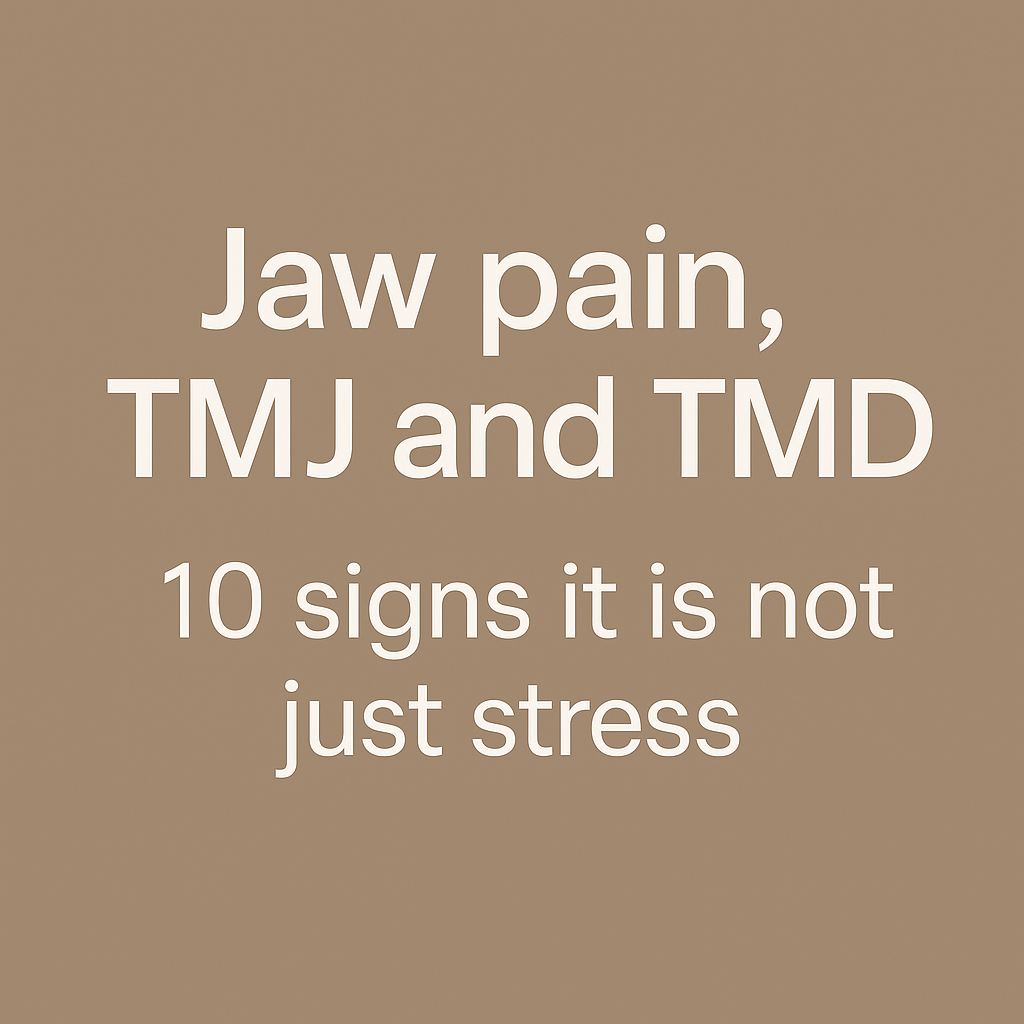
10 signs your jaw pain might be TMJ or TMD: why it is so often missed
Jaw pain is easy to brush off.
Most people blame stress, grinding, a bad pillow or a busy week at work. For many, though, jaw pain is part of a deeper problem in the temporomandibular joint, the TMJ, and the muscles that help you chew and speak.
Temporomandibular disorders, usually shortened to TMD, sit in an awkward space between dentistry, pain medicine and neurology. That is one reason so many people are dismissed, misdiagnosed or left to cope alone. These ten signs will not give you a diagnosis, but they may help you recognise when jaw pain deserves proper attention.
“TMJ and TMD are not just stress. If they are changing your life, they need a name and a plan.”
1. Persistent jaw pain that keeps coming back
Short lived aches after a long day of talking or chewing are one thing. Pain that keeps returning for weeks or months, especially on one or both sides of the jaw near the ear, is different. If you find yourself planning meals or social events around your jaw, it is a warning sign.
2. Clicking or popping every time you open your mouth
Many people notice a click or pop in the jaw but are told that everyone’s jaw does that. A single, quiet click now and then may be harmless. A loud, repeated click or pop, especially with pain or a sense of the jaw shifting out of place, can be linked to TMJ or TMD.
3. Your jaw feels stiff, tight or “stuck”
Difficulty opening your mouth wide, for example at the dentist or when yawning, is a common feature of TMD. Some people describe a feeling that the jaw catches, sticks or will not move smoothly. In more severe cases, the jaw can lock open or closed, which is frightening and needs assessment.
4. Pain that spreads to the ear, temple or cheek
TMJ related pain does not always stay in the joint. It can spread into the ear area, the side of the head, the cheek or down into the neck. Many people are treated repeatedly for ear or sinus problems before anyone looks carefully at the jaw joint itself.
5. Headaches that seem to start around the jaw
For some, jaw tension and clenching trigger headaches. If you wake with pain around the temples, side of the head or face, and you also notice jaw symptoms, it may be worth asking whether TMJ or TMD is part of the picture, not just stress or tension headaches.
6. Chewing has become hard work
You might find you avoid tougher foods, chew on one side or feel your jaw tiring quickly when you eat. Some people say they feel as if they have run a marathon with their jaw after a meal. If chewing has quietly reshaped your diet, your jaw is telling you something.
7. Your bite feels off but your teeth look fine
A subtle feeling that your teeth no longer meet properly, without obvious dental damage, can be linked to changes in the way the jaw joint and muscles are working. It is important that a dentist rules out tooth problems, but it is equally important that they consider the TMJ as well.
8. Your jaw pain worsened during stress or after dental work
Stress, grinding and clenching can certainly aggravate TMD. So can long periods with your mouth open for dental treatment. None of this means it is all in your head. It means the joint and muscles are already vulnerable and are responding to extra strain from daily life, anxiety or procedures.
9. You have other long term pain conditions
Many people with TMJ or TMD also live with other long term pain conditions such as migraine, neck and back pain, pelvic pain, fibromyalgia or irritable bowel symptoms. The labels are different, but the experience of not being believed or joined up in the system is painfully similar.
10. You have been told it is just stress but nothing improves
One of the most consistent stories I hear is this. People are given vague reassurance, maybe a short course of tablets, and sent away without a clear name for their pain. Months or years later they discover TMJ or TMD almost by accident.
You are allowed to expect more than that. You are allowed to ask for a proper examination of the jaw joints and muscles, not just a quick look at your teeth or ears.
What to do if these signs feel familiar
These ten points are not a checklist for self diagnosis. They are a prompt to be taken seriously.
If this feels like your story, you might want to:
• Speak to your dentist or GP and ask directly whether TMJ or TMD has been considered.
• Ask for a simple, clear explanation of what they see when they examine your jaw joints and muscles.
• Keep a short diary of your jaw pain, clicking, locking and headaches. It can help you and your clinicians see patterns more clearly.
If your jaw pain sits alongside facial pain, electric shock sensations or other complex symptoms, charities such as TNA UK can offer further information, peer support and a helpline where people understand what you are living with.
You can read more about TMJ, TMD and facial pain support on the TNA UK website and contact their free helpline for advice and information.
“If TMJ or TMD pain is shaping what you eat, say and do, it is not a habit or a quirk. It is a health condition and you deserve help.” – Aneeta Prem
You can also use this shorter version on social media if you wish:

Understanding the safeguarding gaps exposed by Sara Sharif’s case, and the protections the new Bill must deliver.

10 signs your jaw pain might be TMJ or TMD: why it is so often missed

Iraq’s 2025 Child Marriage Law Allows Girls as Young as Nine: A Human Rights Crisis

Britain’s Grooming Gangs Inquiry: Why Clarity and Trust Matter More Than Ever

Progress 1000 Evening Standard: a list of London’s most influential people.

Launch of Cut Flowers, My New Novel on FGM A year ago. Sitting on the sofa eating chocolate we were chatting...